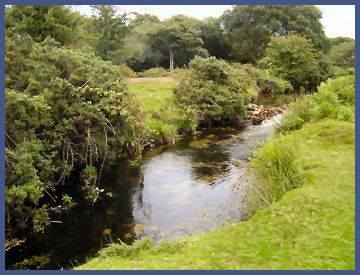OS Grid ref:- SX 088 738
 The ancient Cornish village of St. Breward on Bodmin Moor has the distinction of being the highest village in Cornwall, standing at 720 feet above sea level.
The ancient Cornish village of St. Breward on Bodmin Moor has the distinction of being the highest village in Cornwall, standing at 720 feet above sea level.
The village's only pub The Old Inn, has stood on the site since the eleventh century, there is a post office, a church and a shop.
St. Breward is well known for its granite and china clay industries and provided the stone for London Bridge.
The village derives its name from its church, St. Brueredus, which was founded in 1278 and is situated at the northern end of the village The exterior of the church is Norman and a substantial building, it is constructed of Caen Stone. The south aisle and western tower are fifteenth century additions and are built in granite. The building was sympathetically restored in the nineteenth century, and only parts of the Norman north arcade remain.
 In the mediaeval times three chapels existed in the parish: at Hamatethy the manorial chapel of the Norman Peverell family , St Michael's Chapel, Roughtor, and another at Chaple. The historian Thomas Taylor was the vicar here and edited the parish registers.
In the mediaeval times three chapels existed in the parish: at Hamatethy the manorial chapel of the Norman Peverell family , St Michael's Chapel, Roughtor, and another at Chaple. The historian Thomas Taylor was the vicar here and edited the parish registers.
Hamatethy Manor house and estate are situated around half a mile to the north of St Breward. The Manor of Hamatethy dates back to before the Norman Conquest. After 1066 it was held by Count Robert of Mortain, the maternal half-brother of King William the Conqueror. From the twelfth up to the fifteenth century the Manor of Hamatethy was held by the Peverell family, suspected to be descendants of William the Conqueror though an illegitimate line, it then passed to the Hungerford family and later the Mitchell and Onslow families.
In a nearby valley, situated on a public footpath, stands St Breward's Well, also known as St James' well, which is purported to cure sore eyes for an offering of pins. It lies on an ancient sunken track and is near to an old chapel dedicated to St James. The well is first mentioned as far back as 1422. It is recorded said that the poor and afflicted would commonly drop pins or a farthing into its waters as an offering of thanks to the saints who drank here.
Also worth seeing is nearby King Arthur's Hall, on the banks of the De Lank River. Constructed by the ancient Beaker people, the monument is now 2000 years old. There is an interesting old 'clapper bridge' nearby.